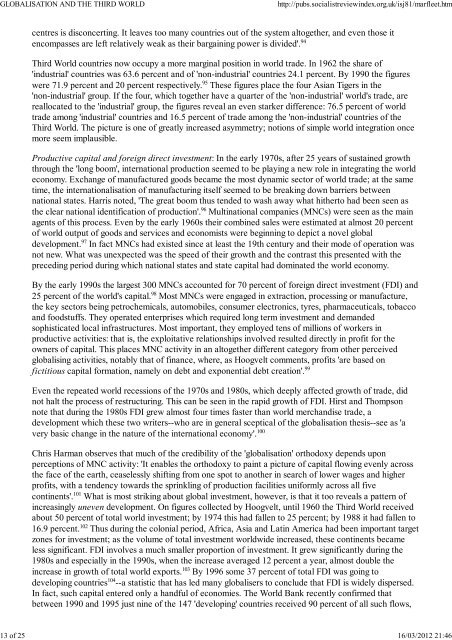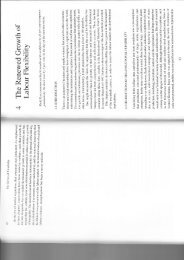GLOBALISATION AND THE THIRD WORLD.pdf - Steerweb.org
GLOBALISATION AND THE THIRD WORLD.pdf - Steerweb.org
GLOBALISATION AND THE THIRD WORLD.pdf - Steerweb.org
Create successful ePaper yourself
Turn your PDF publications into a flip-book with our unique Google optimized e-Paper software.
<strong>GLOBALISATION</strong> <strong>AND</strong> <strong>THE</strong> <strong>THIRD</strong> <strong>WORLD</strong>http://pubs.socialistreviewindex.<strong>org</strong>.uk/isj81/marfleet.htm13 of 25 16/03/2012 21:46centres is disconcerting. It leaves too many countries out of the system altogether, and even those itencompasses are left relatively weak as their bargaining power is divided'. 94Third World countries now occupy a more marginal position in world trade. In 1962 the share of'industrial' countries was 63.6 percent and of 'non-industrial' countries 24.1 percent. By 1990 the figureswere 71.9 percent and 20 percent respectively. 95 These figures place the four Asian Tigers in the'non-industrial' group. If the four, which together have a quarter of the 'non-industrial' world's trade, arereallocated to the 'industrial' group, the figures reveal an even starker difference: 76.5 percent of worldtrade among 'industrial' countries and 16.5 percent of trade among the 'non-industrial' countries of theThird World. The picture is one of greatly increased asymmetry; notions of simple world integration oncemore seem implausible.Productive capital and foreign direct investment: In the early 1970s, after 25 years of sustained growththrough the 'long boom', international production seemed to be playing a new role in integrating the worldeconomy. Exchange of manufactured goods became the most dynamic sector of world trade; at the sametime, the internationalisation of manufacturing itself seemed to be breaking down barriers betweennational states. Harris noted, 'The great boom thus tended to wash away what hitherto had been seen asthe clear national identification of production'. 96 Multinational companies (MNCs) were seen as the mainagents of this process. Even by the early 1960s their combined sales were estimated at almost 20 percentof world output of goods and services and economists were beginning to depict a novel globaldevelopment. 97 In fact MNCs had existed since at least the 19th century and their mode of operation wasnot new. What was unexpected was the speed of their growth and the contrast this presented with thepreceding period during which national states and state capital had dominated the world economy.By the early 1990s the largest 300 MNCs accounted for 70 percent of foreign direct investment (FDI) and25 percent of the world's capital. 98 Most MNCs were engaged in extraction, processing or manufacture,the key sectors being petrochemicals, automobiles, consumer electronics, tyres, pharmaceuticals, tobaccoand foodstuffs. They operated enterprises which required long term investment and demandedsophisticated local infrastructures. Most important, they employed tens of millions of workers inproductive activities: that is, the exploitative relationships involved resulted directly in profit for theowners of capital. This places MNC activity in an altogether different category from other perceivedglobalising activities, notably that of finance, where, as Hoogvelt comments, profits 'are based onfictitious capital formation, namely on debt and exponential debt creation'. 99Even the repeated world recessions of the 1970s and 1980s, which deeply affected growth of trade, didnot halt the process of restructuring. This can be seen in the rapid growth of FDI. Hirst and Thompsonnote that during the 1980s FDI grew almost four times faster than world merchandise trade, adevelopment which these two writers--who are in general sceptical of the globalisation thesis--see as 'avery basic change in the nature of the international economy'. 100Chris Harman observes that much of the credibility of the 'globalisation' orthodoxy depends uponperceptions of MNC activity: 'It enables the orthodoxy to paint a picture of capital flowing evenly acrossthe face of the earth, ceaselessly shifting from one spot to another in search of lower wages and higherprofits, with a tendency towards the sprinkling of production facilities uniformly across all fivecontinents'. 101 What is most striking about global investment, however, is that it too reveals a pattern ofincreasingly uneven development. On figures collected by Hoogvelt, until 1960 the Third World receivedabout 50 percent of total world investment; by 1974 this had fallen to 25 percent; by 1988 it had fallen to16.9 percent. 102 Thus during the colonial period, Africa, Asia and Latin America had been important targetzones for investment; as the volume of total investment worldwide increased, these continents becameless significant. FDI involves a much smaller proportion of investment. It grew significantly during the1980s and especially in the 1990s, when the increase averaged 12 percent a year, almost double theincrease in growth of total world exports. 103 By 1996 some 37 percent of total FDI was going todeveloping countries 104 --a statistic that has led many globalisers to conclude that FDI is widely dispersed.In fact, such capital entered only a handful of economies. The World Bank recently confirmed thatbetween 1990 and 1995 just nine of the 147 'developing' countries received 90 percent of all such flows,




